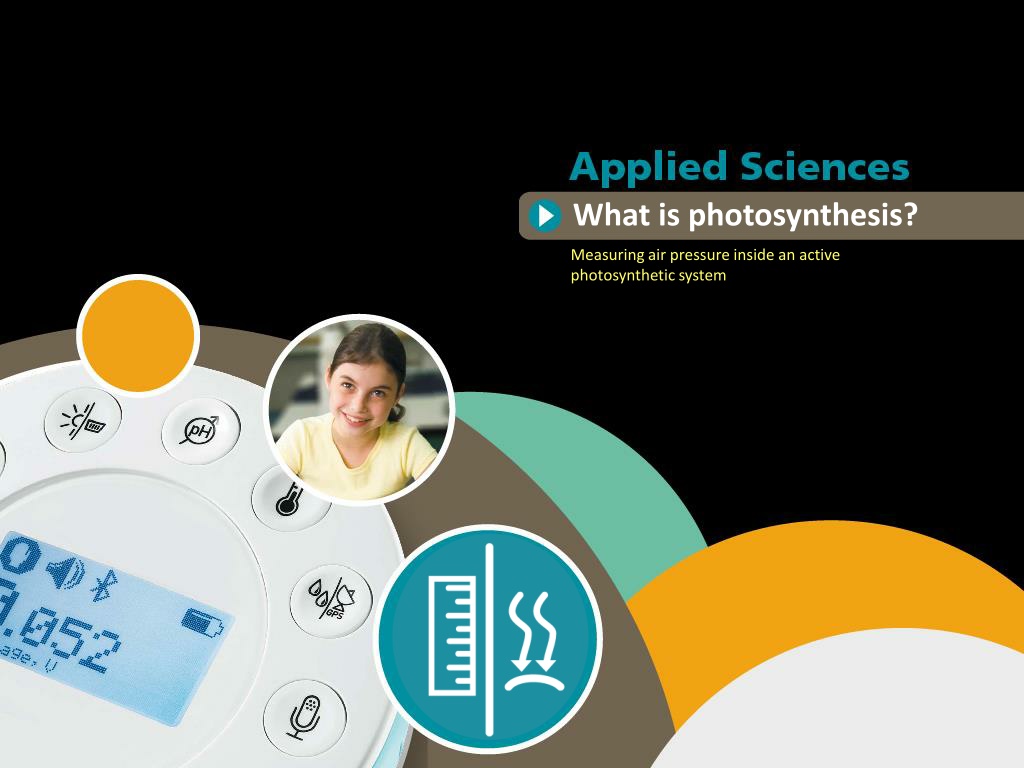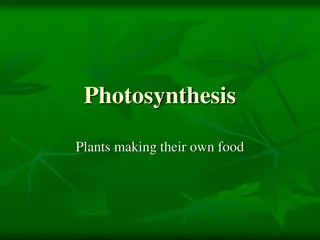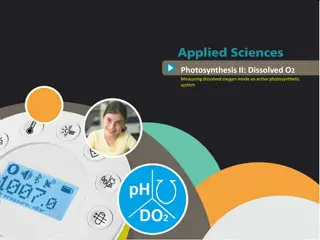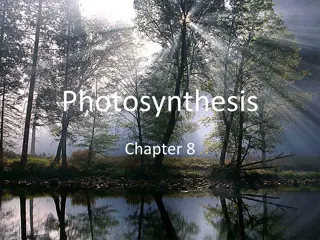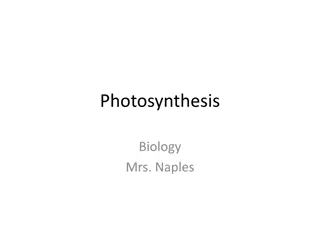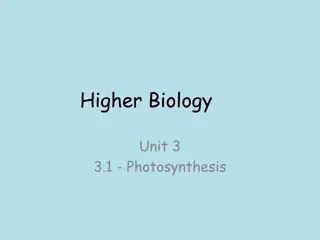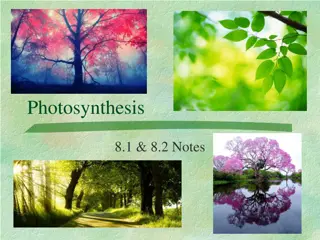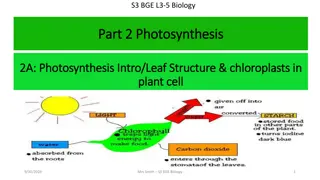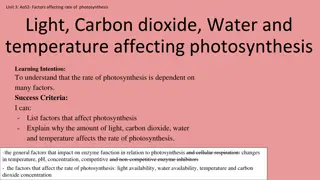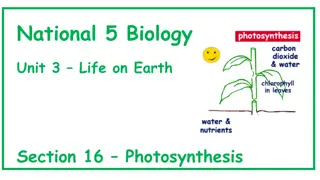Exploring Photosynthesis Through Air Pressure Measurement in Active Systems
This activity focuses on studying air pressure changes within a closed photosynthetic system to understand the process of photosynthesis. Students learn the key concepts behind photosynthesis, its importance for living organisms, and how plants produce energy through this metabolic process. By measuring air pressure variations, students can test hypotheses and determine if photosynthesis is occurring within the system. Theoretical aspects of photosynthesis, including the conversion of light energy into chemical energy, are explored to provide a comprehensive understanding of this vital biological process.
Download Presentation

Please find below an Image/Link to download the presentation.
The content on the website is provided AS IS for your information and personal use only. It may not be sold, licensed, or shared on other websites without obtaining consent from the author. Download presentation by click this link. If you encounter any issues during the download, it is possible that the publisher has removed the file from their server.
E N D
Presentation Transcript
What is photosynthesis? Measuring air pressure inside an active photosynthetic system
What is photosynthesis? Measuring air pressure inside an active photosynthetic system Objective The purpose of this activity is to study air pressure variation inside a closed system in which photosynthesis is taking place, creating a hypothesis and proceeding to test it using the air pressure sensor of the SensorLab.
What is photosynthesis? Measuring air pressure inside an active photosynthetic system Introduction and theory The aim of the introduction is to focus students on the subject of the class by refreshing acquired knowledge and asking questions which can encourage the research development. Then, key concepts of the theoretical framework which will be used by the students during the class are taught. Introduction All living organisms need energy to survive. That s the reason why we humans eat, to get the necessary energy from what we consume. However, not all living organisms obtain energy through the same process. Just as there are organisms that eat others to obtain energy, there are also some organisms that can synthesize chemical compounds for living. This is the case with organisms like plants, alga and some types of bacteria. They are able to synthesize glucose, a molecule that is vital to their metabolic functions, through the process of photosynthesis.
What is photosynthesis? Measuring air pressure inside an active photosynthetic system Introduction and theory What elements or factors are necessary to fulfill our energetic needs? How do we call the metabolic processes plants perform for living? Carry out the experiment activity with your class so that at the end you ll be able to answer the following question. How could we detect that photosynthesis is really happening inside an organism?
What is photosynthesis? Measuring air pressure inside an active photosynthetic system Introduction and theory Theoretical Photosynthesis is a process used by organisms like plants, alga and some photosynthetic bacteria to obtain nutrients. Broadly speaking, it is the process of converting light energy from the sun to chemical energy. Next we present the overall general reaction that is involved in the process: The former equation represents a set of chemical reactions, where light energy is used to break apart six water molecules (H2O) into hydrogen (H) and oxygen (O2), which are released into the environment. The hydrogen obtained from the water molecule bonds to six CO2 molecules, obtaining glucose (C6H12O6 ).
What is photosynthesis? Measuring air pressure inside an active photosynthetic system Introduction and theory There are two stages to photosynthesis
What is photosynthesis? Measuring air pressure inside an active photosynthetic system Introduction and theory Photosynthesis takes place inside a cell organelle specialized for this process, the chloroplast. The chloroplast has a system of membranes, the inner and the outer membrane. Within the inter-membrane space are the thylakoids, which are a kind of elongated flattened sack. These sacks are stacked in a granum. Finally, there is the stroma, which is the fluid occupying all the spaces left between the thylakoids.
What is photosynthesis? Measuring air pressure inside an active photosynthetic system Introduction and theory Despite having different colors of pigment, only one of them is essential to the process of photosynthesis, and common to all photosynthetic organisms. This special pigment is called chlorophyll, and is responsible for the green color we observe in most plants. The light reaction (light-dependent phase) occurs in the thylakoid membrane, where the chloroplast can store light energy due to the presence of chlorophyll. This is the reason why light is vital to the reaction. On the other hand the dark reaction (light-independent phase) takes place in the stroma of the chloroplast, and its final product is glucose. This phase takes place during night and day, but it is called dark reaction because it doesn t need light to be present. It is important to highlight the cycle produced thanks to photosynthesis. As animals breath they use oxygen (O2) from the air and release carbon dioxide (CO2) into the environment. Meanwhile, plants take the CO2 and release O2 in exchange. The oxygen is then taken by the animals, repeating the cycle.
What is photosynthesis? Measuring air pressure inside an active photosynthetic system Introduction and theory Now students are encouraged to raise a hypothesis which must be tested with an experiment. Suppose you place an active photosynthetic plant inside a closed system, what would you expect to be the pressure variation inside?
What is photosynthesis? Measuring air pressure inside an active photosynthetic system Activity description After placing a photosynthetic organism inside a syringe, students will measure the pressure. They will relate their observations to the results obtained during the experiment, and proceed to display them in a graph for analysis.
What is photosynthesis? Measuring air pressure inside an active photosynthetic system Resources and materials SensorLab 3 grams of elodea canadiens aquatic plant Barrel and plunger of a 60 ml. syringe Air pressure silicon tube supplied with the SensorLab Paper towel Water Laboratory clamp for small tubes Nut Laboratory stand Lamp with a 100 watts vial
What is photosynthesis? Measuring air pressure inside an active photosynthetic system Using the SensorLab a. Using the SensorLab To perform the measurements with the SensorLab air pressure sensor, the SensorLab must be configured according to the following steps: Turn on the SensorLab by pressing Open the GlobiLab software. To perform this activity we recommend using wireless communication. If your computer does not support Bluetooth, you may use USB connection. Please refer to the Quick Start Guide, supplied with the SensorLab to learn how to set the Bluetooth communication and how to pair your device with the computer.
What is photosynthesis? Measuring air pressure inside an active photosynthetic system Using the SensorLab When using the Bluetooth communication - right click on the Bluetooth icon in the lower right corner of the GlobiLab s screen and select the SensorLab you are using. The icon will change from grey to blue indicating that the SensorLab and the computer are now connected via Bluetooth communication . In order to use USB communication, connect the SensorLab and the computer with the USB cable supplied in the SensorLab box. Click on the USB icon at the bottom right corner of the software screen. This icon will turn blue, indicating that the SensorLab is connected to the computer via USB .
What is photosynthesis? Measuring air pressure inside an active photosynthetic system Using the SensorLab Click on the button to configure the SensorLab. In the Logger setup window select the air pressure sensor, 1/min in rate and 100 in samples .
What is photosynthesis? Measuring air pressure inside an active photosynthetic system Experiment The following steps explain how to perform the experiment: Take the piston out of the syringe barrel. Block the opening of the syringe and place a fresh elodea canadiens with 50 ml. of water inside. Insert the plunger back inside the syringe barrel and leave about 10 ml. of air in the syringe. Connect the air pressure tube between the syringe and the SensorLab air pressure sensor port.
What is photosynthesis? Measuring air pressure inside an active photosynthetic system Experiment Once you have finished, arrange the display as shown in the figure, using the SensorLab, the laboratory clamp, the nut, the laboratory stand and the lamp. Make sure the SensorLab is connected hermetically to the syringe. MAKE SURE NO WATER FLOWS FROM THE SYRINGE THROUGH THE TUBE INTO THE SensorLab!
What is photosynthesis? Measuring air pressure inside an active photosynthetic system Experiment Place the experiment setting in a new place and turn on the lamp at a distance of 5 cm. Start measuring for 24 minutes by pressing the RUN icon in the GlobiLab software. Observe the plant and register your observations. Press the STOP icon in the GlobiLab software when you have completed the measurements.
What is photosynthesis? Measuring air pressure inside an active photosynthetic system Results and analysis The following steps explain how to analyze the experiment results: Observe the graph displayed on the screen. If necessary, fit the scale to observe the variations displayed. You can do this by registering the maximum and minimum vales using the button, then right click on the y axis and enter rounded min., max. values in the Set Range dialog box. Press to select data points on the graph and pick the extreme points. Then, draw a linear regression by pressing .
What is photosynthesis? Measuring air pressure inside an active photosynthetic system Results and analysis How do the results relate to your initial hypothesis? What was the change in pressure during the experiment? Calculate the increase of air pressure per minute using the markers. What was the rate of air pressure increase in this experiment?
What is photosynthesis? Measuring air pressure inside an active photosynthetic system Results and analysis Repeat the experiment in the same conditions and with double the amount of elodea canadiens. How does the air pressure rate increase in this experiment as compared with the previous one? What effect should we observe if we increase the light intensity of the projector used in this experiment? How would you explain the air pressure variation inside the system?
What is photosynthesis? Measuring air pressure inside an active photosynthetic system Results and analysis The graph below should be similar to the one the students came up with. Air pressure as a function of time
What is photosynthesis? Measuring air pressure inside an active photosynthetic system Conclusions Hereafter are presented some questions and answers which should be developed by the students in order to elaborate their conclusions. How can we infer that photosynthesis is really happening in the system? Students should conclude, from the theoretical background, that the plant is consuming CO2 and releasing oxygen into the environment. Therefore, the oxygen released contributes to the increased air pressure inside the syringe system. How could we know that a gas is being released as a product of photosynthesis? Students should point out that, according to their observations, the plant was producing bubbles that went up across the water column. This indicates that a gas was being released into the air of the system, raising the pressure inside. What does the negative and positive sign of the electric current mean? Students should answer that the gas released during this process is molecular oxygen. This can be concluded by reviewing the general photosynthesis equation, shown in the theoretical background.
What is photosynthesis? Measuring air pressure inside an active photosynthetic system Conclusions Which properties of the system change if you increase the number of oxygen molecules inside? How? Students should observe that if you increase the amount of oxygen inside the system, raising the number of molecules in a given volume, the air pressure will increase just as we observed with the sensor. How would you prove with this experiment that the gas released was oxygen and not another kind of gas? Students should understand that whilst you can make deductions based on the information given in the theoretical background and your previous experience, we are not able to prove (with this experiment) that the gas produced by the plant is indeed oxygen. The same experiment, using the SensorLab BioChem model, measuring DO2 (Dissolved Oxygen) can directly measure the Oxygen released by the elodea canadiens and dissolved in the water.
What is photosynthesis? Measuring air pressure inside an active photosynthetic system Conclusions Students should reach the following conclusions: Photosynthesis is a process taking place in photosynthetic organisms (algae, plants and some bacteria), which have specialized organelles for this function. This organelle is the chloroplast, which in turn needs a specific pigment to perform photosynthesis, called chlorophyll. Active photosynthetic organisms use carbon dioxide to produce glucose, through a series of chemical reactions involving light. As a result, they release oxygen into the environment. In this lesson we studied an aquatic plant inside a closed system, during the process of photosynthesis. We observed an internal pressure rise as the process was taking place, because the plant was releasing oxygen as a product of photosynthesis. On the other hand, even if we can conclude that the gas is oxygen, based the theoretical background, we have no way to prove that it is not another gas with the current experiment.
What is photosynthesis? Measuring air pressure inside an active photosynthetic system Activities for further application The aim of this section is that the students can extrapolate the acquired knowledge during this class through the application of it in different contexts and situations. Furthermore, it is intended that students wonder and present possible explanations to the experimentally observed phenomena. Further questions: Why do you think we used elodea canadiens for this experiment? Students should recognize or investigate some of the characteristics of this aquatic plant as a good model to study, since some examples would be a high photosynthetic rate, plus the need for specific care in raising and storage etc.
What is photosynthesis? Measuring air pressure inside an active photosynthetic system Activities for further application What method other than oxygen detection would you use to indicate photosynthesis? Students should think about alternative methods to study photosynthesis. One example could be the detection of other chemical compounds involved in the reaction with glucose. Another example could be the measurement of reactants consumption, like carbon dioxide. During this class the photosynthesis process was studied measuring the air pressure inside a closed system using the air pressure sensor. However, the sensor is not able to discriminate different gas types and therefore it was concluded from the theoretical background, that it was oxygen. How would you prove that the gas is oxygen? Explain. Students should suggest and explain strategies to prove that the gas responsible for the air pressure increase inside the system was indeed oxygen. For example, they could suggest bringing a flame into contact with the air of the system and measuring the flame size. An increase in flame size would indicate air rich in oxygen, because oxygen is needed for the process of burning.
What is photosynthesis? Measuring air pressure inside an active photosynthetic system Activities for further application According to the information from the theoretical background, do you think that trees and plants with leafs that are not green, have also green pigments, or only pigments the color of their foliage? Students should remember that the only pigment present in all photosynthetic organisms is chlorophyll (which is the green pigment), because it is vital to the process of photosynthesis. Therefore, all plants should have chlorophyll and if we see another color it is due to the presence of other kinds of pigments masking the green of chlorophyll. What do you think would happen if all plants were to become extinct? Explain. Students should understand that in the case of all plants dying out, there would remain only few organisms capable of performing photosynthesis (only some bacteria and alga). This would cause a serious drop in the amount of oxygen in the air, in turn causing problems for all aerobic organisms (organisms that breathe oxygen). Additionally, students may notice that autotroph organisms are fundamental to all food chains, because they synthetize their own food taking molecules from the air. If plants (autotroph organisms) were to become extinct, a lot of terrestrial organisms would also die out.
